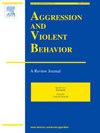Public or private violence? Understanding the overlap between intimate partner abuse and susceptibility to violent extremism
IF 3.4
2区 心理学
Q1 CRIMINOLOGY & PENOLOGY
引用次数: 0
Abstract
The link between intimate partner abuse (IPA) and violent extremism has become an area of media and policy interest – sparked both by newly emerging extremes (e.g., Involuntary Celibates; incels) and high-profile attacks where the offender had previously perpetrated IPA. These developments blur the boundaries between forms of violence traditionally treated in silos of public and private (domestic) violence. However, while IPA has been observed as present in the backgrounds of a range of violent offenders, including extremists, it is important for the risk assessment and management of both to understand if and how IPA is relevant to violent extre risk. To unpack this relationship, we apply psychometric network analysis to survey responses from a sample of men from the UK general population. A series of network graphs visualise how IPA perpetration, attitudes towards violence against women, attitudes towards violence, exposure to violent extremism, and violent extremist attitudes and intentions relate to one another. Our findings suggest that IPA may be an observable (although admittedly crude) indicator of the types of attitudes which underpin both types of violence, and that exposure to violent extremism may, in part, explain the blurring of boundaries increasingly observed in practice. We introduce a number of protective factors into the models to visualise how they might mitigate risk, to inform the design and delivery of risk management in this space.
公共暴力还是私人暴力?了解亲密伴侣虐待和暴力极端主义易感性之间的重叠
亲密伴侣虐待(IPA)与暴力极端主义之间的联系已成为媒体和政策关注的一个领域-由新出现的极端主义(例如,非自愿独身者;叛乱分子)和高调的袭击,罪犯以前犯下了IPA。这些发展模糊了传统上被视为公共暴力和私人(家庭)暴力的暴力形式之间的界限。然而,虽然在包括极端分子在内的一系列暴力罪犯的背景中观察到IPA的存在,但了解IPA是否以及如何与暴力极端风险相关对于风险评估和管理都很重要。为了揭示这种关系,我们应用心理测量网络分析来调查来自英国普通人群的男性样本的反应。一系列网络图表可视化显示了IPA犯罪、对暴力侵害妇女行为的态度、对暴力的态度、接触暴力极端主义以及暴力极端主义态度和意图之间的相互关系。我们的研究结果表明,IPA可能是一种可观察到的(尽管不可否认是粗糙的)指标,表明支持这两种暴力的态度类型,并且暴露于暴力极端主义可能部分解释了在实践中越来越多地观察到的边界模糊。我们在模型中引入了许多保护性因素,以可视化它们如何降低风险,为该领域风险管理的设计和交付提供信息。
本文章由计算机程序翻译,如有差异,请以英文原文为准。
求助全文
约1分钟内获得全文
求助全文
来源期刊

Aggression and Violent Behavior
Multiple-
CiteScore
7.50
自引率
4.30%
发文量
63
期刊介绍:
Aggression and Violent Behavior, A Review Journal is a multidisciplinary journal that publishes substantive and integrative reviews, as well as summary reports of innovative ongoing clinical research programs on a wide range of topics germane to the field of aggression and violent behavior. Papers encompass a large variety of issues, populations, and domains, including homicide (serial, spree, and mass murder: sexual homicide), sexual deviance and assault (rape, serial rape, child molestation, paraphilias), child and youth violence (firesetting, gang violence, juvenile sexual offending), family violence (child physical and sexual abuse, child neglect, incest, spouse and elder abuse), genetic predispositions, and the physiological basis of aggression.
 求助内容:
求助内容: 应助结果提醒方式:
应助结果提醒方式:


